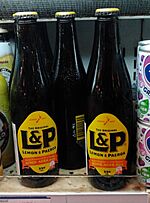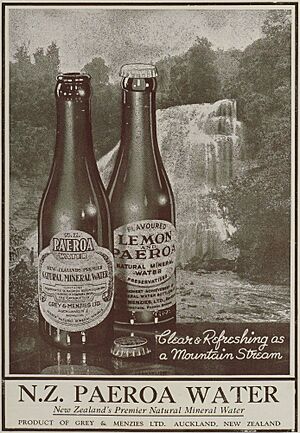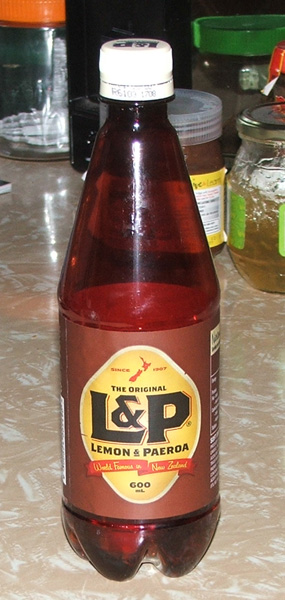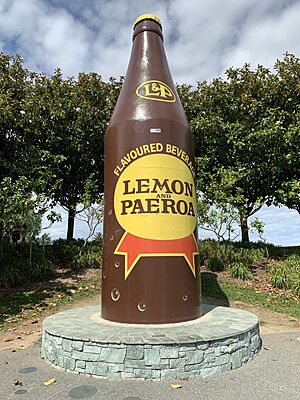- This page was last modified on 17 October 2025, at 10:18. Suggest an edit.
Lemon & Paeroa facts for kids

Lemon & Paeroa on sale in Shanghai
|
|
| Type | Soft drink |
|---|---|
| Manufacturer | Coca-Cola Europacific Partners |
| Country of origin | Paeroa, New Zealand |
| Introduced | c. 1907 |
| Colour | Pale, light yellow |
| Variants | Sugar Free, Sour, Dry Ginger Beer, Chilli & Lime (limited edition) |
Lemon & Paeroa, often called L&P, is a sweet, lemon-flavoured soft drink from New Zealand. It's a famous New Zealand icon, known as Kiwiana. Long ago, it was made by mixing lemon juice with naturally fizzy mineral water from the town of Paeroa. Today, a big company called Coca-Cola makes it. No one is completely sure when it started, but the company thinks it was around 1907.
In Paeroa, where the drink began, there's a huge L&P bottle statue. It's about 7 metres tall! This statue is one of the most photographed spots in New Zealand. It's also seen as a symbol of the country.
Contents
History of L&P
Lemon & Paeroa first used natural fizzy water from a spring in Paeroa. This spring was near the Ohinemuri and Waihou rivers. Before it became famous, the land around the spring was used for gold mines and later as a cow field. Local people often visited the spring to drink its water.
In 1909, a man named Robert Fewell started bottling this spring water to sell. He built a factory that could bottle many drinks each day. His company, the Paeroa Natural Mineral Water Company, sold plain mineral water.
Later, in 1915, Grey & Menzies Limited bought the company and the spring land. By November 1915, they started advertising "Lemon and Paeroa." They had a "new idea" to add lemon to the Paeroa mineral water.
For many years, the water was sent from Paeroa to a factory in Auckland. There, the Lemon & Paeroa drink was made. In 1934, L&P started being made in the Paeroa factory too. Over the years, different companies owned L&P. Finally, in 1989, Coca-Cola bought the company that made L&P.
By the 1970s, the water used in Lemon & Paeroa was made artificially. It no longer came directly from the Paeroa spring. This was done to make sure the taste was always the same. In July 1980, the Paeroa factory closed. All L&P production moved to Auckland, where Coca-Cola makes it today.
In 1995, some people complained that the drink should be renamed. They felt it was wrong to call it "Lemon & Paeroa" if the water didn't come from Paeroa. However, the authorities decided no change was needed.
Bottle Designs and Look
In the early 1980s, L&P started selling bigger two-litre bottles. Before that, the largest size was 1.25 litres.
The look of the L&P bottle and label has changed several times. In 2005, the brand was updated to have a "retro" or old-fashioned style. This new look was advertised before it appeared in stores. This helped people recognise the new bottles. In 2012, the design was changed again to look more modern. The cream-coloured lid became yellow. The branding changed once more in 2016. This included a new logo and different bottle shapes for each L&P flavour.
In 2022, Coca-Cola said they were thinking about changing the plastic bottles from brown to clear. This would make the bottles easier to recycle. Some people, like the Mayor of Hauraki, Toby Adams, were worried. They felt the brown bottle was a famous part of L&P. But Adams believed people would accept the change if they knew it was for recycling. He also thought the big L&P statue in Paeroa would still attract tourists, no matter the bottle colour.
Summer Cans
In October 2018, special summer cans were released. They had a spelling mistake, saying "Cook Straight" instead of "Cook Strait." The mistake was fixed after the first batch, but some cans with the error were still sold. Some experts wondered if this was a clever marketing trick.
The 2023 summer cans were special because they included both English and Māori words. This was the first time this had happened.
Flavours and Types
L&P has introduced many different flavours over the years. A sugar-free version came out in 2005. A dry ginger beer flavour was added in 2009, and a sour flavour in 2013. In October 2016, a limited edition Chilli & Lime flavour was launched. It had a fun, Mexican-themed look. The company described its taste as "Like getting kicked by a baby donkey."
L&P has also been used in other foods. These include a Whittaker's chocolate bar in 2013 and a Griffin's L&P biscuit around 2017. There was also an L&P Fruju ice block in 2017. In 2020, a Pineapple lumps-flavoured L&P drink was available for three months.
In 2019, L&P made a special set of ten very tall bottles, about 70 cm high. One of these bottles sold for over $1,000 online!
Attractions
Big Lemon & Paeroa Bottle
In Paeroa, there is a giant L&P bottle that is about 6.8 metres tall. It's one of New Zealand's most famous sights. Many people take photos with it. The bottle started in 1967 as a rocket for Christmas. It was later turned into the L&P bottle for Christmas 1968. It was moved in 1969 to be a permanent attraction. In 2002, it was moved again to the Ohinemuri Reserve to make it safer for visitors. A park has since been built around the statue.
In 2013, when L&P teamed up with Whittaker's for a chocolate bar, a Whittaker's van was placed next to the statue. It looked like the van had crashed into the bottle. This was a fun advertising stunt.
Lemon & Paeroa Café
The L&P brand team runs a café that opened in December 2000. This café sells food with L&P flavour. You can find L&P ice-cream, eggs benedict with L&P sauce, and L&P pork ribs. Outside the café, there is another L&P bottle statue, about 5.8 metres tall. This is different from the bigger 6.8-metre statue in the Ohinemuri Reserve. Having two statues in Paeroa has caused some discussion. The café also has a souvenir shop. It was updated in 2015.
Marketing and Advertising
L&P has had many memorable advertisements. In 1978, a piece of music written for an L&P ad won a special award. In 1988, a music video for L&P was named the best commercial in New Zealand.
A very famous TV ad from the 1990s used the song "Counting the Beat" and the slogan "World famous in New Zealand." This ad was filmed in Paeroa, showing the L&P statue. In the early 2000s, an ad campaign encouraged people to only drink L&P. This campaign helped sales grow a lot.
In 2005, a big advertising campaign changed the slogan to "World famous in New Zealand since ages ago." These ads made fun of old-fashioned things from the 1970s and 1980s.
L&P also created "3D pop-out billboards" in 2014. These billboards had free gifts like sandals and towels that people could take. In 2015, they ran a Snapchat campaign called the "Trickshot Challenge." People would buy special cans and do trickshots, then share them on Snapchat.
A "Backyard Cricket" campaign showed friends and family playing cricket with unusual gear. The idea was to connect L&P with fun New Zealand activities that everyone could relate to. Another campaign in 2017, called "On the lamb," showed sheep drinking L&P and doing fun things in small New Zealand towns.
In 2019, L&P released an ad with zombies in a city. Some people complained it was scary for kids and played too early. The Advertising Standards Authority didn't stop the ad, but it was later moved to play after 7 pm.
In 2021, L&P launched a campaign called "Space Manu." It showed a man in a space suit doing a cannonball dive, or manu, into a pool. In 2023, L&P created "Manu Applied Sciences Aotearoa" (MASA), which looked like NASA. They even made an L&P swimsuit for doing the manu.
"World Famous in New Zealand"
The slogan "World Famous in New Zealand" was created in 1993 for Lemon & Paeroa. The people who made the campaign wanted to celebrate unique New Zealand things. The ads would playfully say that Paeroa wasn't famous for big city things, but then show the L&P bottle statue and say, "But, it is famous!" This ad was very popular and ran for over ten years. Now, the phrase is used in everyday talk to describe things that are loved by local people.
In 2005, the slogan was changed for a short time to "World famous in New Zealand since ages ago."
The slogan was officially protected by a trademark in 2004. A man named Tony Coombe tried to challenge this, saying the phrase belonged to all New Zealanders. However, the High Court decided that Coca-Cola had the right to keep the trademark.
See also
 In Spanish: Lemon & Paeroa para niños
In Spanish: Lemon & Paeroa para niños
- List of lemon dishes and beverages
- Lemon & Te Aroha



